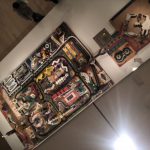Sarah Lucas’ exhibit features pieces that really challenge the standards of society. Once the elevator doors open, you’re found face to face with a wall plastered with tips of penises. This is just the beginning. All around the exhibit, there are exposures of private body parts of both women and men. There are objects that symbolize or represent male genitals and women’s vaginas, but create a more revealing aspect of society.
A lot of pieces put on display at first seem to be uncomfortable and strange that male genitals are being presented in public. However, there are a lot of pieces that seem to have been around for a long time in the sense that Sarah Lucas is working towards a certain movement. Especially during the current time of women empowerment and the ‘Me Too’ movement, Lucas exposure of male genitals challenge the harassment and exposures of women over history. A lot of times, women are the one being exposed and it is seen as a social norm. By using such sensitive parts of the body and turning them into art, Lucas speaks a louder statement of how natural it has become to expose women.
Enlarge

In a sense, it almost feels like she is returning the favor to men. A lot of the pieces bring in male genitals as well and tell a much deeper story. In the piece, Spamageddon 2004, a chair, tights, kapok, spam cans, and military helmets are featured. In doing so, Lucas seems to reveal a connection between sex and death. It challenges the idea of sex being so casual and instead used as something to bring immediately to those who were about to face death. It reveals an unpleasant characteristic of men using women as sexual objects.
In another piece, Lucas creates almost a board game looking piece out of an article that exposes men who had strange sexual contacts. They were all arrested and their faces were shown to the public. It reveals the nature in which men see women and sex as more of a game of erotic nature rather than the intimacy and closeness that sex is supposed to represent.
The idea of death is also represented in Lucas’ pieces by her use of cigarettes in many of her pieces. In her piece, Christ You Know It Ain’t Easy (2003), Christ’s resurrection is constructed of cigarettes. It is said that cigarettes are often used in Lucas piece to represent the destruction of man upon themselves. In other words, the cigarettes represent self-destruction and how humans take action that goes against their own selves.
Enlarge

Lucas is able to show the world how provocative and unjustified man can be towards women and even themselves. It brings an exposure to man that seems uncomfortable but is necessary to make a statement. The exhibit allows for an urgency to change society and the norms that have been created and unchallenged over the years. The exhibit really flares out these needs to find real respect for all people of all types.
Lucas makes use of visuals and material that is not looked greatly upon by the public. She is able to challenge her audience to look further into the exposure of women in the media and how they are used as media entertainment rather than respected women. The exhibit demonstrates how art can be extremely revealing to the world and the way the pieces are set allows you to really experience the art rather than just looking at the art. Because the art pieces are not kept behind any restrictions, every detail of each piece is extremely revealing, allowing for the parallelism of exposing humans to feel naked and exposed of their self-destruction. It is quite an experience to see the exposure Lucas brings to her exhibit and it brings hope to the empowerment of women as it says something louder than just pieces of art.




I also related Lucas’s work to the “Me Too” movement. I like how pointed out that the exposure of male genitals challenges the traditions in history. This reminded me of how it is acceptable, and sometimes even normal to see women’s bodies overly exposed, objectified, and devalued in media and advertisement, but you would never see this same treatment to men’s bodies.
I like how you pointed out that Lucas was almost “returning the favor”, so to speak, to men when it comes to objectification and sexualization of women and their bodies. As a woman I found Lucas’ work really refreshing because many contemporary artists use women’s body very loosely to achieve “edgy” and (not-so) “liberated” art pieces, but do so much less commonly with male bodies and that in itself speaks volumes about the perceived differences between men and women.